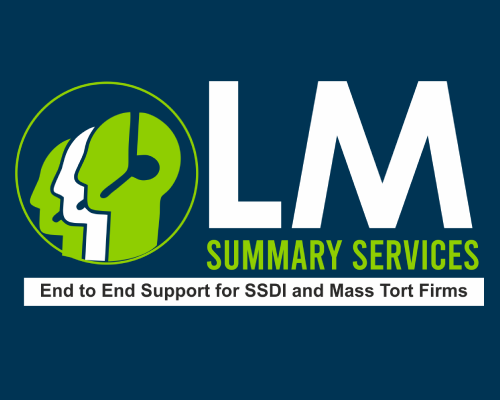Introduction
Although studies have continuously suggested that people form their opinion of a website within 50 milliseconds of first visit and that 94% of first impressions are design related, Disability Law Marketing's own internal conversion data points to another major factor in connecting with would be SSDI applicants at the highest possible rate.
For SSDI law firms and advocates, a website not only represents a virtual office, identity, and reputation, but also an opportunity to demonstrate to applicants that their emotional reality is not overlooked.
Hiring a high-end creative agency to develop a fancy or trendy website does not ensure connecting with potential SSDI applicants. Conversely, opting for a low-cost web vendor, or buying a generic theme and DIYing it, is not the best approach for building a website and does not address the needs of SSD benefits applicants.
With over 15 years in the SSDI space, at DL Marketing we pride ourselves on having a deep understanding of SSD applicants and craft websites to address their emotional needs.
"For SSDI law firms and advocates, a website not only represents a virtual office, identity, and reputation, but also an opportunity to demonstrate to applicants that their emotional reality is not overlooked"
In this article, we’ll dive into website design best practices that SSDI firms and advocates should consider. Aside from highlighting the strengths and facts of the firm or advocacy, a great SSDI website needs to also incorporate tailored experiences for each type of impairment or disability. Once this initial planning is done, then come the preparations for the aesthetics, user interface, interactive widgets (such as CTAs and chat-boxes), and content.
Building UI/UX Design Concept around Comfort and Familiarity

The saying “first impressions are the most lasting” holds true, especially in the realm of successful retail stores, where specific storefront decor, the strategic placement of welcome signs, order, cleanliness, and friendly smile upon entering aim to ensure customers feel comfortable and at ease. These stores strive to endear themselves to customers from the moment they step inside.
Similarly, SSDI firms must seek to establish a lasting impression of approachability and friendliness, aside from professionalism and competence, throughout their websites.
"A great design and website experience can be achieved when SSDI firms and advocates possess a deep understanding of their clients' profiles"
The aesthetics and user interface of an SSDI website play a crucial role in conveying a firm or advocacy's expertise and empathy towards potential applicants and clients. A clean, accessible design with a clear hierarchy between more and less vital information will lead to users staying on the website longer because they will be able to easily find what they were looking for.
Effective Use of Colors

When planning the design of an SSDI website, the brand's color palette may need to be reconsidered to incorporate a scheme that evokes trust and reliability, such as blues or greens. The design team (made up of stakeholders and vendor personnel) needs to avoid loud or clashing colors not just between the sections of each page such as the header, footer, main banner, navigation, CTAs, but also when it comes to text and topography.
Text & Typography

Always keep your audience (the disabled community over 50 years old) in mind when it comes to text. Never utilize light-colored text on a light-colored background and vice versa. The same principle applies to typography; make sure it is clear, with ample spacing to accommodate readers with visual impairments.
Photography & Imagery

Aside from text and typography, carefully consider the photography and imagery you will utilize. High-quality images and graphics that reflect the reality of your clientele and the long and complicated SSD process.
Navigation

Effective navigation is key to ensuring visitors can easily find the information they’re looking for. A well-structured main nav with straightforward labels helps users quickly locate important sections like services offered, attorney profiles, impairments covered, the SSD application process, and contact information without confusion.
However, throwing everything into the main navigation is not necessarily the best practice. Top-performing websites incorporate secondary and tertiary navigation. While this might seem contradictory to the principle of simplicity and ease of use, conversion data continuously proves that giving users multiple ways to find useful pages leads to better engagement. These additional navigation panes can be on the side panel and footer of a website.
Incorporating a search function and a FAQ section can also significantly enhance the user experience, allowing for quick access to specific information.
A great design and website experience can be achieved when SSDI firms and advocates possess a deep understanding of their clients' profiles. Chances are, these individuals are unaware of the long journey ahead and the many challenges with their SSD application. They will visit the website with a range of emotions that may lead to them dropping off. An SSDI firm or representative's website must avoid a user experience that is complicated or overwhelming.
Do You Trust My CTA Button?

In a church portico in Rome, tourists often hesitate to place their hands inside the mouth of a statue known as the Bocca Della Verita, or Mouth of Truth, due to the fear of the unknown. Only those who trust their tour guide’s assurance dare to do so.

Similarly, a poorly designed Call-to-Action (CTA) button conjures the same fear and uncertainty.
Without establishing trust, users won't dare click on the button thinking it will take them where they don't want to go or do. Clicking on the CTA indicates that users trust the website and are willing to proceed, making it the most crucial indicator of the website’s overall success.
Therefore, the most effective websites are built on trust.
That's why companies that paired a social proof with a clear CTA saw a 68% increase in conversion rates, while those that added 'doubt removers' beneath their CTAs saw up to a 124% improvement
SSDI firms and advocates implementing CTA strategies can build trust by strategically positioning CTAs (buttons, forms, phone numbers, etc.) throughout the webpage and surrounding them with assurances of solutions and support. These assurances frequently appear as short-form content, testimonials, and case studies. Effective websites continually mix and match these elements for optimization. Ideally, websites should feature five well-placed CTAs across every page to maximize their chances of connecting with applicants.
However, using CTAs comes with responsibility. Trust must be nurtured and reciprocated after visitors utilize it. As such, SSDI firms and advocates must respond promptly when users sign up or make inquiries to foster trust and maintain credibility.
Is there Anyone Real I Can Talk to? Human Connection and SSDI Chatbox
A marketing consultant was brought in to offer professional advice on increasing sales for a travel agency. Upon arrival, the consultant admired the office decor, adorned with feature posters, promotions, and travel destination packages. Employees were diligently working in their designated sections and cubicles, all lined up and prepared to assist customers. Despite the impressive setup, it was evident to the consultant what the travel agency’s primary issue was.
“Who do I approach first in your office?” the consultant inquired.
In essence, the only missing piece in the office is the front door receptionist.
Now, you may wonder who should be the website's front-door receptionist?
It's the chatbox!
"86% of consumers prefer humans to bots, while 71% said they would be less likely to use a brand if they're not talking to a real person"
SSDI firms and reps must recognize that potential leads often have specific needs beyond what website content alone can address. Given the unique nature of each case, visitors may require guidance (akin to approaching a front desk for inquiries). A chatbox serves as an accessible option, reassuring users that the website is available to assist them at all times. This feature enables users to receive real-time answers or detailed explanations to their queries.

However, for an enhanced client interaction, it’s crucial for SSDI firms to consider employing human representatives instead of bots in the chatbox. Besides, 86% of consumers prefer humans to bots, while 71% said they would be less likely to use a brand if they're not talking to a real person.
For SSDI firms and reps, these statistics should be obvious. Their potential leads are often anxious and frustrated due to the challenges associated with their disability. To effectively convert them into clients, relying on a chatbot to alleviate their concerns may not suffice. Instead, having a real person available to engage with visitors is essential. A human representative can grasp the context, understand the weight of the situation, and appreciate the consequences involved - elements that cannot be adequately addressed by a bot, especially in the nuanced processes of SSDI cases.
Mobility Equals Commitment – The Importance of Mobile Optimization in SSDI Law firms

Today, the effectiveness of a website hinges on its responsiveness to visitors’ needs, particularly considering that most internet users now browse on smartphones and tablets. According to data from February 2024, mobile browsers in the United States have surpassed desktop usage, with 54.21% of users accessing the internet via mobile compared to 43.27% on desktop. Meanwhile, 2.53% accessed the net with their tablets.
SSDI firms and representatives should prioritize developing responsive websites that can adjust to and cater to different screen sizes. This isn’t merely about keeping up with the latest trend; SSDI firms undertake this to cater to the special needs of their clients. Individuals with physical disabilities often encounter challenges in digital environments unlike those without disabilities commonly face.
"SSDI websites should keep their mobile versions predictable and consistent on different screens"
Therefore, mobile optimization entails responsiveness to accommodate clients. In this context, design features aren’t solely about increasing font sizes or incorporating flashy colors.
There are many creative elements to be considered in mobile optimization for people with disabilities, but it's impossible to cover all of them. Fortunately, SSDI firms and reps aren't expected to push design limits here. What they should focus on instead is simplicity. A clean and simple design for mobile versions will appeal to a wider audience. The only rule they need to follow is to make the text content readable and understandable.

And because 85% of adults think that a company's website when viewed on a mobile should be as good or better than its desktop version, SSDI websites should keep their mobile versions predictable and consistent on different screens. The underlying principle here is to convey a reassuring message to clients that the firm is always inclusive and empathetic to their needs.
Content Without AIDA is Just a Word Salad: A Sure-Fire Way to Engage SSDI Clients

Implementing all the above optimal practices for designing an SSDI website is a great start. But when it comes to content, merely having a website filled with legal jargon and paragraphs of text will not drive the most engagement. On average, visitors spend 5.59 seconds only scanning a website's written content. Thus, content must grab an applicant's attention as quick as a wink.
However, effectively engaging with potential SSDI clients lies in the content’s ability to not just catch the person’s attention with great titles and headlines, but to hold it, generating true interest, and naturally providing a path towards decisive action. This is where the AIDA model - Attention, Interest, Desire, Action - becomes crucial.
The form of the content, on the other hand, needs to embrace the reality of our shrinking attention spans in today’s digital world.
Numerous studies have consistently shown a decline in attention spans over time. In fact, some research has drawn parallels between modern attention spans and those of a goldfish! So yes, landing page headlines need to be as impactful and compelling as a delicious shrimp is to a fish. But how can SSDI firms and advocates move a reader from attention to interest to desire and finally action?

First, start by tailoring content to an applicant's reality; emotional and otherwise. Give readers real and tangible solutions to their specific problems, their impairment/disability, or their disappointment and frustration with the SSD application process.
Next, ensure your content is written for your ideal customer profiles and incorporate storytelling or a narrative style. Consider the struggles of an average client: typically, over the age of 49, grappling with disability, unable to work, and burdened with mounting financial responsibilities.
Lastly, SSDI content should not be strictly text-based and devoid of visual storytelling. Potential clients will not slog long paragraphs of text that strain their eyes.
The average person spends 37 seconds reading a blog post. This reality must be considered to avoid chasing readers away with daunting walls of text.
Here's how to make content easier to digest and drive applicants into engaging with your firm or advocacy:
- Regardless of wordcount, break up text with headings and subheadings;
- Include interesting points and facts as bullet points;
- Include relevant images or video content to visually compel readers (and as a bonus, multimedia content adds authority to your article, showing you've done research to back up your points);
- And don't forget to format paragraphs themselves. The flow of your writing is just as important to the visual and hierarchical structure.
Conclusion
Based on the emotional reality of SSDI applicants, firms and advocates need to design every element of their website to fit the needs of their target audience.
SSDI firms and reps need to cultivate a positive atmosphere in their UI/UX design, considering that users might visit the site already welled-up with negative feelings. A well-designed SSDI websiite can address this by ensuring easy access and multiple navigation options to important and tailored information.
Trust plays a pivotal role in prompting visitors to utilize CTAs. Reading assurances and "doubt-removers" across the webpage will elicit users to go ahead with CTA prompts.
Chatboxes alleviate doubt and instill a sense of security through quick-access support. For SSDI websites, visitors find it more reassuring to engage in a chat with a human representative who they can empathize with their case.
Meanwhile, mobile optimization is re-contextualized for SSDI websites to be particularly inclusive toward persons with disabilities.
Finally, content must be tailored to move an SSD audience from attention to interest to action with real examples and stories, presented in a captivating and pleasing style.
A Website that Builds on Trust
Do you need an exceptional SSDI website that stands out amongst a crowd of boring legal templates and provides your clients and what they really need? Trust DL Marketing's 15+ years of scaling SSD practices to design and deploy a website that converts visitors into SSDI applicants and clients.
Contact Disability Law Marketing today to discover how we can help you build trust with your potential clients, build stronger connections, and create a lasting impact.





 Home
Home